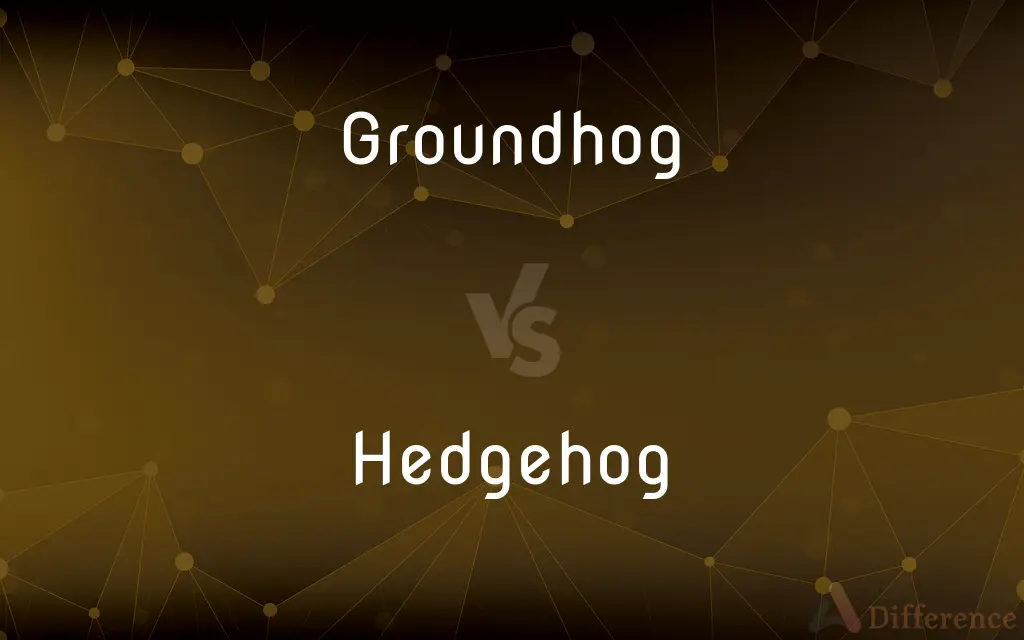Groundhog vs. Hedgehog — What's the Difference?
Edited by Tayyaba Rehman — By Fiza Rafique — Updated on November 3, 2023
Groundhogs are large rodents known for burrowing, while hedgehogs are small, spiny mammals that roll into balls for defense.

Difference Between Groundhog and Hedgehog
Table of Contents
ADVERTISEMENT
Key Differences
Groundhogs, also known as woodchucks, belong to the group of large ground squirrels. Hedgehogs are distinguished by their spiny backs and are unrelated to groundhogs.
Groundhogs are North American natives, hibernating in winter, and known for their digging prowess. Hedgehogs are primarily found in Europe, Asia, and Africa and are notable for their unique defense mechanism of curling into a ball, where their spines protect them.
The groundhog has become popularly associated with Groundhog Day, a cultural event predicting the arrival of spring. Hedgehogs are often characterized in folklore and children's literature, portraying them as wise and solitary creatures.
While groundhogs are considered agricultural pests at times due to their burrowing, hedgehogs are often welcomed for their consumption of garden pests.
Groundhogs have a mainly herbivorous diet, feasting on a variety of vegetation. Hedgehogs, on the other hand, are omnivorous, eating insects as well as fruits and vegetables.
ADVERTISEMENT
Comparison Chart
Habitat
Native to North America.
Found in Europe, Asia, and Africa.
Physical Traits
Large, stout body with brown fur, short legs.
Small, round body with spines, capable of rolling.
Behavior
Known for burrowing and hibernation.
Known for curling into a ball for defense.
Cultural Significance
Associated with Groundhog Day.
Featured in folklore and literature.
Diet
Herbivorous, eating grasses and plants.
Omnivorous, eating insects and plants.
Compare with Definitions
Groundhog
Also known as a woodchuck.
Groundhogs, or woodchucks, are excellent diggers.
Hedgehog
Nocturnal and insectivorous.
At night, the hedgehog hunts for insects.
Groundhog
A North American rodent that predicts spring.
The groundhog saw its shadow today.
Hedgehog
Found commonly in gardens.
A hedgehog scurried through the underbrush.
Groundhog
A hibernating animal.
The groundhog hibernates during the winter months.
Hedgehog
A small, spiny mammal that rolls into a ball.
The frightened hedgehog curled into a tight ball.
Groundhog
Known for creating extensive burrows.
A groundhog's burrow can be quite elaborate.
Hedgehog
Has a coat of sharp spines.
The hedgehog's spines deter predators.
Groundhog
A member of the squirrel family.
That groundhog has been raiding my vegetable garden.
Hedgehog
A hedgehog is a spiny mammal of the subfamily Erinaceinae, in the eulipotyphlan family Erinaceidae. There are seventeen species of hedgehog in five genera found throughout parts of Europe, Asia, and Africa, and in New Zealand by introduction.
Groundhog
The groundhog (Marmota monax), also known as a woodchuck, is a rodent of the family Sciuridae, belonging to the group of large ground squirrels known as marmots. The groundhog is a lowland creature of North America; it is found through much of the eastern United States, across Canada and into Alaska.
Hedgehog
Any of several small insectivorous mammals of the subfamily Erinaceinae, native to Eurasia and Africa and naturalized in New Zealand, having dense erectile spines covering the back and sides and characteristically rolling into a ball for protection.
Groundhog
Another term for woodchuck
Hedgehog
Any of several spiny animals, such as the porcupine, that are similar to the hedgehog.
Groundhog
See woodchuck.
Hedgehog
A well fortified military position.
Groundhog
A red-brown marmot, Marmota monax, native to North America.
Hedgehog
An antisubmarine weapon consisting of several rows of mortar-like dischargers positioned to fire in a circular pattern ahead of a ship.
Groundhog
(rare) The aardvark.
Hedgehog
An obstacle used against tanks and landing craft, consisting of three crossed iron bars welded or bolted together.
Groundhog
A reddish brown North American burrowing marmot (Marmota monax), also called the woodchuck. It hibernates in the winter.
Hedgehog
A small mammal, of the family Erinaceidae or subfamily Erinaceinae (pl=s, the latter characterized by their spiny back and often by the habit of rolling up into a ball when attacked.)
Groundhog
Reddish brown North American marmot
Hedgehog
(US) Any of several spiny mammals, such as the porcupine, that are similar to the hedgehog.
Hedgehog
(military) Czech hedgehog an antitank obstacle constructed from three steel rails.
Hedgehog
A spigot mortar-type of depth charge weapon from World War II that simultaneously fires a number of explosives into the water to create a pattern of underwater explosions intended to attack submerged submarines. Category:en:World War II
Hedgehog
(Australia) A type of chocolate cake (or slice), somewhat similar to an American brownie.
Hedgehog
A form of dredging machine.
Hedgehog
Certain flowering plants with parts resembling a member of family Erinaceidae
Hedgehog
Medicago intertexta, the pods of which are armed with short spines.
Hedgehog
Retzia capensis of South Africa.
Hedgehog
The edible fungus Hydnum repandum.
Hedgehog
A kind of electrical transformer with open magnetic circuit, the ends of the iron wire core being turned outward and presenting a bristling appearance.
Hedgehog
A way of serving food at a party, consisting of a half melon or potato etc. with individual cocktail sticks of cheese and pineapple stuck into it.
Hedgehog
(differential geometry) A type of plane curve; see Hedgehog (geometry). Category:en:Curves
Hedgehog
(military) To make use of a hedgehog barricade as a defensive maneuver.
Hedgehog
To array with spiky projections like the quills of a hedgehog.
Hedgehog
(ambitransitive) To curl up into a defensive ball.
Hedgehog
A small European insectivore (Erinaceus Europæus), and other allied species of Asia and Africa, having the hair on the upper part of its body mixed with prickles or spines. It is able to roll itself into a ball so as to present the spines outwardly in every direction. It is nocturnal in its habits, feeding chiefly upon insects.
Hedgehog
The Canadian porcupine.
Hedgehog
A species of Medicago (Medicago intertexta), the pods of which are armed with short spines; - popularly so called.
Hedgehog
A form of dredging machine.
Hedgehog
A variety of transformer with open magnetic circuit, the ends of the iron wire core being turned outward and presenting a bristling appearance, whence the name.
Hedgehog
A defensive obstacle having pointed barbs extending outward, such as one composed of crossed logs with barbed wire wound around them, or a tangle of steel beams embedded in concrete used to impede or damage landing craft on a beach; also, a position well-fortified with such defensive obstacles.
Hedgehog
Relatively large rodents with sharp erectile bristles mingled with the fur
Hedgehog
Small nocturnal Old World mammal covered with both hair and protective spines
Hedgehog
Does not hibernate but may sleep through cold weather.
The hedgehog nestled in leaves to stay warm.
Common Curiosities
Can you keep a hedgehog as a pet?
Yes, in some places, hedgehogs can be kept as pets.
Do hedgehogs have natural predators?
Yes, they are preyed upon by larger mammals and birds of prey.
Are groundhogs and hedgehogs related?
No, they belong to different mammal families.
Are groundhogs good for gardens?
No, they can be destructive to gardens due to their burrowing.
What kind of environments do hedgehogs prefer?
They like areas with plenty of ground cover and access to food.
Do both groundhogs and hedgehogs hibernate?
Groundhogs hibernate, while hedgehogs may enter a state of torpor in cold climates.
How do hedgehogs protect themselves?
They roll into a ball, with spines outward to deter predators.
When do groundhogs come out of hibernation?
They usually emerge in early spring.
What do groundhogs eat?
They primarily eat vegetation such as grasses, fruits, and plants.
Can groundhogs climb?
Yes, they are capable climbers.
Are hedgehogs spines poisonous or harmful?
No, the spines are not poisonous, but they can be sharp.
Is Groundhog Day a reliable predictor of weather?
It is a folk tradition, not scientifically reliable.
How long do groundhogs live?
In the wild, they typically live 6-8 years.
Can hedgehogs swim?
Yes, they can swim if necessary.
Do hedgehogs make good garden pets?
They can be beneficial by eating pests, but they should not be treated as pets.
Share Your Discovery

Previous Comparison
Omission vs. Commission
Next Comparison
Thunderstorm vs. ThunderAuthor Spotlight
Written by
Fiza RafiqueFiza Rafique is a skilled content writer at AskDifference.com, where she meticulously refines and enhances written pieces. Drawing from her vast editorial expertise, Fiza ensures clarity, accuracy, and precision in every article. Passionate about language, she continually seeks to elevate the quality of content for readers worldwide.
Edited by
Tayyaba RehmanTayyaba Rehman is a distinguished writer, currently serving as a primary contributor to askdifference.com. As a researcher in semantics and etymology, Tayyaba's passion for the complexity of languages and their distinctions has found a perfect home on the platform. Tayyaba delves into the intricacies of language, distinguishing between commonly confused words and phrases, thereby providing clarity for readers worldwide.















































